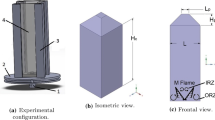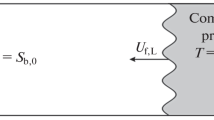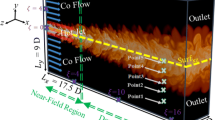Abstract
A problem formulation is proposed for simulating lean premixed hydrogen–air combustion in a closed volume with numerically generated turbulence. Two-dimensional simulations of flame propagation from a small ignition kernel showed that the following sequence of regimes is observed with increasing turbulence intensity and decreasing mixture strength: a corrugated flame with a continuously connected front, a regime with a local loss of front connectivity, and flame extinction through disintegration of a growing kernel into fragments. The transition from steady self-sustained combustion to extinction corresponds to changes in mixture and turbulence parameters leading to a stronger influence of turbulent velocity field on local flame structure. The proposed approach to numerical simulation of the transition regime characterized by loss of front connectivity and fragmentation of the flame under the action of turbulent eddies can be used to evaluate the effect of turbulence intensity on flammability limits.
Similar content being viewed by others
Avoid common mistakes on your manuscript.
INTRODUCTION
The aim of fundamental research on combustion of gases is to analyze the influence of various factors on flammability limits and combustion characteristics of fuel-air mixtures. Knowledge of the physical mechanisms underlying particular combustion regimes is necessary when developing new and improving existing technical systems, as well as when justifying safety measures at facilities whose operation involves the use or generation of gaseous fuel-air mixtures. Of particular interest are combustible mixtures containing hydrogen, which is both a promising fuel [1] and a hazardous reactant generated and accumulated in industrial facilities, such as nuclear power plants [2]. When an accident is in progress at a nuclear power plant, convection currents that occur in the containment building mix the hydrogen released from the damaged reactor core with air, water vapor, and other gaseous components [2]. Accidental ignition of the resulting combustible mixture by a local energy source can lead to an explosion and ensuing destruction of the containment. Recommendations for preventing and mitigating such explosions are generally based on the flammability and combustion characteristics of premixed gases [3–5].
In traditional approaches to experimental study of premixed combustion [6, 7], critical conditions are determined for steady self-sustained flame propagation from a local ignition source in a closed volume. In particular, the lean flammability limit for quiescent hydrogen–air mixtures under normal conditions at normal gravity corresponds to a volume fraction of hydrogen from 4 [3] to 6% [5]. However, it should be noted that so-called ultra-lean combustion (with hydrogen percentage varying from 4–6 to 9–10%) always occurs in the form of spherical “caps” [8, 9] driven upwards by buoyancy [10]. It was shown in [11] that the main mechanism responsible for extinction of ultra-lean flames is the stretching of the front of an initially spherical kernel by the flow induced by its buoyancy-driven rise. Combustion dies out after the front breaks at its leading point and the hydrogen concentration (less than 4–6%) becomes insufficient to sustain exothermic reaction in the resulting flame fragments. A similar quenching mechanism can occur when a flame propagates from a spark kernel in strong turbulence. Flame stretching by the strongest eddies gives rise to portions of the front protruding into the fresh mixture (“flame tongues”) and their breaking away from the main flame [12, 13]. Quenching of the separate kernels formed as a result of a loss of front connectivity can lead to complete cessation of combustion. It has been experimentally established that, when turbulence is sufficiently strong, self-sustaining flame propagation is impossible even far from the flammability limits determined for quiescent mixtures [14]. The influence of this scenario of turbulent flame extinction on burning velocity and flammability limits [15] has been poorly studied and is of interest for analysis of combustion regimes in practical systems [16], including prospective engines [17] and explosion suppression systems [18].
In this paper, we propose a numerical simulation approach to study lean premixed hydrogen–air combustion in a closed volume with numerically generated turbulence. As a result of solving the formulated problem, possible combustion regimes are visualized for mixtures with hydrogen concentration in air ranging from 5 to 10%.
FORMULATION OF THE PROBLEM
The main difficulty of direct numerical simulation of premixed combustion in real systems is the need to resolve local flame structure characterized by a length scale on the order of flame thickness, 1 mm for lean hydrogen–air mixtures under standard conditions. In addition, detailed kinetic mechanisms must be used to more accurately reproduce quantitative characteristics of combustion. Both factors impose severe restrictions on the choice of simulation parameters, which narrow the scope of direct numerical simulation due to limited computational resources. In particular, 3D simulation of premixed hydrogen–air combustion can be performed only in a small computational domain, and a comprehensive study of flame structure and evolution is feasible only in a 2D setup. A direct comparison of DNS results with experimentally observed lean premixed hydrogen–air flame dynamics [19] has shown that both flame structure and front geometry obtained in 2D simulations closely correspond to 3D experimental data. The 2D simulations presented in [10, 11] are in satisfactory agreement with experimental data on flammability limits at normal gravity [9] and microgravity [3–5]. Based on the flame extinction mechanism described in [11], it can be assumed that interaction of a flame front with a two-dimensional flow can accurately reproduce quantitative characteristics of a real flame (at least for lean hydrogen–air mixtures). In numerical simulations of turbulent combustion, it is advisable to use synthetic homogeneous isotropic turbulence generated as a stationary process. Although the characteristics of stationary turbulence differ between 2D and 3D geometries [20], taking into account the remarks made above, we restrict ourselves to considering two-dimensional turbulence. A similar approach was proposed in [21], where the solution of a two-dimensional problem quantitatively reproduced some experimentally observed characteristics of turbulent combustion of hydrogen–air mixtures.
The computational domain is a 80-by-80-mm square with adiabatic slip walls. At the first stage, isotropic turbulence is generated in a combustible mixture of given composition. Next, the turbulent mixture is ignited by a point source in the center of the domain. This geometry is close to the conditions of experiments [22], where combustion was studied under conditions of stationary homogeneous isotropic turbulence generated in the central region of a constant-volume chamber by fans located at the periphery of the chamber.
The motion of a premixed gas is described by the Navier–Stokes equations written in the weakly compressible approximation [10], which is valid for reacting flows whose velocities are low compared to the speed of sound. To simulate well-developed homogeneous isotropic turbulence, we use the following model proposed earlier in [23]. In each computational cell, we consider a stochastic velocity perturbation defined as a time-dependent Wiener process with unit variance and zero mathematical expectation, which ensures the correct diffusion law for disturbances in the velocity field. In this formulation, the flow velocity components in each grid cell have the form
where ud is the deterministic component obtained by solving the equations of gas dynamics and us is the stochastic component, with a factor k setting the turbulence level, γ is a standardized Gaussian random variable (with unit variance and zero mean), and τ is the time step.
Random perturbation of the velocity field in an initially quiescent gas gives rise to a flow obeying the Navier–Stokes equations and simultaneously experiencing perturbations at each grid point and at each time step. The developing process quickly reaches a steady state in terms of disturbance energy (fluctuation amplitude) for all values of k, domain size, and grid cell size used in the simulations. A characteristic fluctuating velocity trace illustrating a stationary process at k = 100 is shown in Fig. 1a. Figure 1b shows the corresponding two-dimensional flow field. In this formulation of the problem, disturbances dissipate on scales smaller than the computational cell.
The description of gas dynamics of combustion adopted in this study is standard [24] and includes thermal conductivity, viscosity, multicomponent diffusion, the equation of state of a multicomponent reacting gas, and kinetics of hydrogen oxidation calculated by using the mechanism described in [25]. It should be noted here that, in contrast to problems where the use of a one-step reaction of hydrogen oxidation is justified (as in studies of detonation propagation and diffraction [18, 26]), when solving unsteady combustion problems, and even more so when studying near-limit combustion, the use of detailed kinetic mechanisms is essential. The computations were carried out using the algorithm proposed in [27] for solving gas-dynamics problems in the weakly compressible approximation. To resolve flame structure, the cell size was set to 0.1 mm (the flame thickness for the relatively richest mixture, which contained 10% hydrogen, was estimated to be 1 mm and was resolved with ten cells).
RESULTS AND ITS DISCUSSION
To analyze turbulent combustion regimes, we invoke two dimensionless parameters: the Damköhler number Da and the Karlovitz number Ka. The Damköhler number is defined as
where LT is the integral length scale of a turbulent flow, δL is the laminar flame thickness, sL is the laminar burning velocity, and u' is the velocity fluctuation amplitude.
The Karlovitz number is defined as
where η = LTRe–3/4 is the Kolmogorov scale, Re is the turbulent Reynolds number calculated from the integral scale LT and the velocity fluctuation amplitude u'.
Figure 2a shows a diagram illustrating modern concepts of turbulent combustion regimes associated with dominant local structure of the flame brush. Line Ka = Kas represents a tentative boundary between regimes I and II, corresponding to a weakly perturbed and strongly curved front (in standard terminology, wrinkled flame and corrugated flame), respectively. The curvature and stretching of the front in these regimes are not sufficiently high to disrupt local flame structure on scales on the order of flame thickness, and it remains similar to the structure of a laminar flame. For Ka > Kaq (regime III), strong stretching disrupts quasi-laminar flame structure and the flame is locally extinguished, leading to a loss of front connectivity [13]. When Da > 1, laminar-like local flame structure is destroyed by turbulent eddies. The question of what flame structure should be considered dominant in regime IV remains subject to debate, as does the possibility of self-sustained flame propagation.
Combustion regime diagram (a): I, wrinkled flame; II, corrugated flame; III, broken reaction zones (loss of front connectivity); IV, unsteady combustion and flame extinction by turbulent eddies; (b) typical flame structure in a 10% mixture at u' = 2.0 m/s (regime II, Da = 16, Ka = 1.25); the temperature field is shown.
Following these concepts, let us consider the regimes of combustion of a lean hydrogen–air mixture in a closed volume. Let us start with a mixture containing 10% hydrogen. In this case, in the initially quiescent gas, the flame propagates isotropically from the ignition source and over time engulfs the entire computational domain. The laminar burning velocity is ~0.2 m/s and the flame thickness is about 1 mm. For an integral scale of 80 mm (computational domain size) and a small amplitude of velocity fluctuations (0.2 m/s), combustion occurs in wrinkled flame regime (Ka = 3 × 10–3, regime I in the diagram (Fig. 2a). At a higher amplitude of velocity fluctuations, a highly curved flame front is obtained (corrugated flame, regime II in Fig. 2a). For a 10% hydrogen–air mixture, this is observed at a velocity fluctuation amplitude of 1 m/s. In this case, Ka = 1.25, and no loss of front connectivity was found in the simulations.
With decreasing hydrogen content in the mixture, transition to broken reaction zones (loss of front connectivity) is observed (regime III in Fig. 2a). Thus, in an 8% hydrogen–air mixture at a velocity fluctuation amplitude of ~2 m/s, flame stretching by turbulent eddies leads to the breaking away of insular kernels from the flame (Fig. 3, regime III). In this case, Da = 2.3. In the graph of average burning velocity (curve III in Fig. 4) at the time instant of ~50 ms, the value of the burning velocity undergoes a jump. This phenomenon can be attributed to a loss of front connectivity, when the appearance of several simultaneously growing kernels leads to a sharp increase in the total area of the flame front.
In an even leaner mixture (7% hydrogen in air), velocity fluctuations with an amplitude of 2 m/s, much higher than the local flame velocity, create conditions that prevent steady self-sustained combustion. As an illustration, Fig. 3 (regime IV) illustrates the typical behavior of a dying flame. In this regime, the tendency for the initial flame to disintegrate into parts increases. Unlike in regime III, the resulting individual kernels are in a near-critical state. In a typical situation, such a kernel either gradually fades out or continues to grow slowly for some time before being extinguished. Scatter in the lifetimes and burning rates of these kernels explains the observed fluctuations in total burning rate (curve IV in Fig. 4) until the final extinction after 38 ms. Similar behavior of near-limit turbulent flames was revealed in experiments reported in [15], where it manifested itself as a stepwise increase in pressure in a combustion chamber with fan-stirred turbulence.
CONCLUSIONS
—A formulation of the problem of numerical simulation of turbulent combustion in lean hydrogen–air mixtures is proposed.
—An analysis of the results obtained shows that the key mechanism that determines combustion regimes and limits in highly turbulent mixtures is that of local flame stretching.
—Loss of connectivity of flame front plays an important role in the transition from steady combustion to extinction due to an increase in the intensity of turbulence and a decrease in the concentration of hydrogen.
—The predicted dependence of behavior of the simulated flames on mixture composition and turbulence intensity is consistent with the diagram of regimes classified in accordance with the dominant local flame structure.
—The proposed formulation of the problem can be used to numerically estimate the concentration limits of turbulent combustion and to provide computational and theoretical support for experimental studies.
REFERENCES
J. O. Abe, A. P. I. Popoola, E. Ajenifuja, and O. M. Popoola, Int. J. Hydrogen Energy 44, 15072 (2019).
IAEA-TECDOC-1661 Preprint (IAEA, Vienna, 2011).
H. F. Coward and G. W. Jones, Bull. No. 503 (U. S. Government Printing Office, Washington, 1952).
K. L. Cashdollar, I. A. Zlochower, G. M. Green, et al., J. Loss Prev. Process Ind. 13, 327 (2000).
SAFEKINEX, EU-Project Report (German Fed. Inst. Mater. Res. Test., Berlin, 2002).
R. K. Kumar, J. Fire Sci. 3, 245 (1985).
S. P. Medvedev, B. E. Gel’fand, A. N. Polenov, et al., Fiz. Goreniya Vzryva, No. 4, 3 (2002).
J. Buckmaster, G. Joulin, and P. Ronney, Combust. Flame 79, 381 (1990).
P. D. Ronney, Combust. Flame 82, 1 (1990).
I. S. Yakovenko, M. F. Ivanov, A. D. Kiverin, et al., Int. J. Hydrogen Energy 43, 1894 (2018).
A. D. Kiverin, I. S. Yakovenko, and K. S. Melnikova, J. Phys.: Conf. Ser. 1147, 012048 (2019).
V. P. Karpov and A. S. Sokolik, Dokl. Akad. Nauk SSSR 141, 393 (1961).
S. Yang, A. Saha, W. Liang, et al., Combust. Flame 188, 498 (2018).
R. G. Abdel-Gayed and D. Bradley, Combust. Flame 62, 61 (1985).
E. S. Severin, Combust., Explos. Shock Waves (Engl. Transl.) 21, 320 (1985).
V. Ya. Basevich, A. A. Belyaev, V. S. Ivanov, S. N. Medvedev, S. M. Frolov, F. S. Frolov, and B. Basara, Russ. J. Phys. Chem. B 13, 636 (2019).
M. S. Assad, Kh. Al’khusan, O. G. Penyaz’kov, and K. L. Sevruk, Russ. J. Phys. Chem. B 8, 181 (2014).
S. P. Medvedev, S. V. Khomik, and B. E. Gel’fand, Russ. J. Phys. Chem. B 3, 963 (2009).
V. V. Volodin, V. V. Golub, A. D. Kiverin, et al., Combust. Sci. Technol. (2020). https://doi.org/10.1080/00102202.2020.1748606
E. A. Kuznetsov and E. V. Sereshchenko, JETP Lett. 105, 83 (2017).
V. Ya. Basevich, A. A. Belyaev, S. M. Frolov, and F. S. Frolov, Russ. J. Phys. Chem. B 13, 75 (2019).
V. P. Karpov, E. S. Semenov, and A. S. Sokolik, Dokl. Akad. Nauk SSSR 128, 1220 (1959).
M. F. Ivanov, A. D. Kiverin, and E. D. Shevelkina, Inzh. Zh.: Nauka Innov., No. 8 (20) (2013).
K. Kuo, Principles of Combustion, 2nd ed. (Wiley, Hoboken, NJ, 2005).
A. Keromnes, W. K. Metcalfe, K. A. Heufer, et al., Combust. Flame 160, 995 (2013).
V. N. Mikhalkin, S. P. Medvedev, A. E. Mailkov, and S. V. Khomik, Russ. J. Phys. Chem. B 13, 621 (2019).
K. McGrattan, R. McDermott, S. Hostikka, et al., Fire Dynamics Simulator. Technical Reference Guide, Vol. 1: Mathematical Model (NIST, 2019). https://doi.org/10.6028/nist.sp.1018e6
ACKNOWLEDGMENTS
The simulations were performed using the equipment of the Center for Collective Use of Ultrahigh-Performance Computing Resources of Moscow State University and the computing resources of the Interdepartmental Supercomputer Center of the Russian Academy of Sciences.
Funding
The computer models were developed with the support of grant no. MK-3473.2019.2 of the President of the Russian Federation for the state support of young Russian scientists.
Author information
Authors and Affiliations
Corresponding author
Rights and permissions
About this article
Cite this article
Betev, A.S., Kiverin, A.D., Medvedev, S.P. et al. Numerical Simulation of Turbulent Hydrogen Combustion Regimes Near the Lean Limit. Russ. J. Phys. Chem. B 14, 940–945 (2020). https://doi.org/10.1134/S1990793120060160
Received:
Revised:
Accepted:
Published:
Issue Date:
DOI: https://doi.org/10.1134/S1990793120060160








